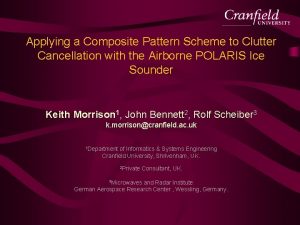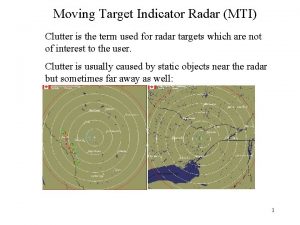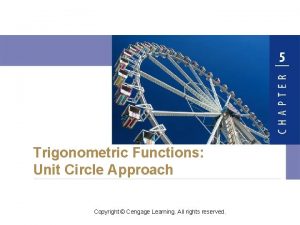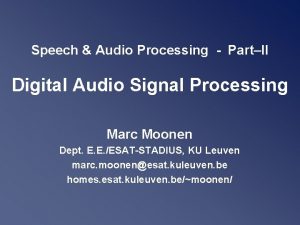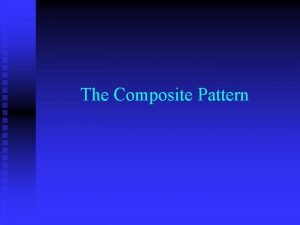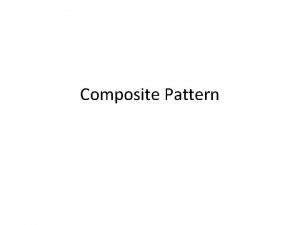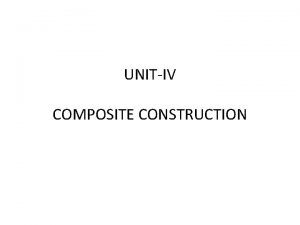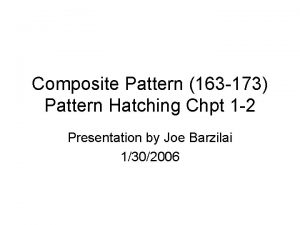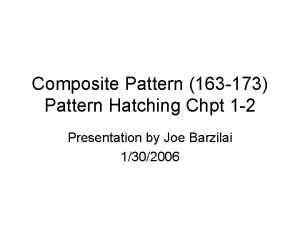Applying a Composite Pattern Scheme to Clutter Cancellation





![ICEGRAV 2011 Test-ID Bandwidth p 110219_m 155222_jsew 1 [MHz] 85 & 30 MHz p ICEGRAV 2011 Test-ID Bandwidth p 110219_m 155222_jsew 1 [MHz] 85 & 30 MHz p](https://slidetodoc.com/presentation_image_h/781b359a5c4a2586b67e231af1aecde9/image-6.jpg)





![4 -ELEMENT : 2 -Null 1 a where: a = -exp[jkdsinϴA] b = -exp[jkdsinϴB] 4 -ELEMENT : 2 -Null 1 a where: a = -exp[jkdsinϴA] b = -exp[jkdsinϴB]](https://slidetodoc.com/presentation_image_h/781b359a5c4a2586b67e231af1aecde9/image-12.jpg)













- Slides: 25

Applying a Composite Pattern Scheme to Clutter Cancellation with the Airborne POLARIS Ice Sounder Keith Morrison 1, John Bennett 2, Rolf Scheiber 3 k. morrison@cranfield. ac. uk 1 Department of Informatics & Systems Engineering Cranfield University, Shrivenham, UK. 2 Private Consultant, UK. 3 Microwaves and Radar Institute German Aerospace Research Center , Wessling, Germany.

COLLABORATORS Matteo Nannini - DLR Pau Prats - DLR Michelangelo Villano - DLR Hugh Corr - BAS ESA-ESTEC Contract: 104671/11/NL/CT Nico Gebert Chung-Chi Lin Florence Heliere

PRESENTATION • Problem • Composite Pattern - convolution - array polynomial • Application • Results

PROBLEM POLARIS R H dhr R air z ice bedrock

ANTENNA ARRAY Geometric alignment and dimensions of the 4 independent receive apertures of the POLARIS antenna
![ICEGRAV 2011 TestID Bandwidth p 110219m 155222jsew 1 MHz 85 30 MHz p ICEGRAV 2011 Test-ID Bandwidth p 110219_m 155222_jsew 1 [MHz] 85 & 30 MHz p](https://slidetodoc.com/presentation_image_h/781b359a5c4a2586b67e231af1aecde9/image-6.jpg)
ICEGRAV 2011 Test-ID Bandwidth p 110219_m 155222_jsew 1 [MHz] 85 & 30 MHz p 110219_m 155222_jswe 1 85 & 30 MHz p 110219_m 155222_jsns 1 85 & 30 MHz p 110219_m 180339_jsns 2 85 & 6 MHz Remarks From east: grounded ice, then crossing the glacier tongue, frozen grounded ice in the middle, ice shelf in the west cross-track slopes with grounded ice profile along the glacier tongue

PROCESSING SCHEME

Rx Pattern Rx Array & Element Pattern

COMPOSITE ARRAY • Phased-array nulling traditionally optimizes performance by utilising available array elements to steer a single null in the required direction. • However, here we exploit the principle of pattern multiplication. • With different element excitations, nulls in differing angular directions are generated. • Composite array is produced by the convolution of two sub-arrays. • The angular response of the composite array is the product of those generated by the individual sub-arrays.

CONVOLUTION The building block is the 2 -element array. To generate a null at angle θA the excitation of the array is required to be: 1. 0 Similarly to generate a null at angle θB the excitation of the array is required to be: 1. 0

3 -ELEMENT : 2 -Null To preserve these nulls we must generate the product of the two patterns and this is achieved by convolving the two distributions to give the following 3 -element distribution: 1 a+b where: a = -exp[jkdsinϴA] b = -exp[jkdsinϴB] ab
![4 ELEMENT 2 Null 1 a where a expjkdsinϴA b expjkdsinϴB 4 -ELEMENT : 2 -Null 1 a where: a = -exp[jkdsinϴA] b = -exp[jkdsinϴB]](https://slidetodoc.com/presentation_image_h/781b359a5c4a2586b67e231af1aecde9/image-12.jpg)
4 -ELEMENT : 2 -Null 1 a where: a = -exp[jkdsinϴA] b = -exp[jkdsinϴB] b 0=-exp[jk 2 dsinϴB] b 0 ab 0

4 -ELEMENT : 3 -Null To generate a third null at angle, θC, requires convolution of the result from the 3 -element, 2 -null case with an additional 2 -element array, with the distribution: 1. 0

SIMULATION Wavelength Range bandwidth Noise power Chirp duration Clutter attenuation Range sampling frequency H=3000 m 0 m 150 m 300 m 500 m 700 m 1000 m

COMPOSITE – 3 3 NULL Double-null with 2° separation centred at left-hand clutter angle

COMPOSITE – 2 2 NULL

ARRAY POLYNOMIAL • This is done using Schelkunoff scheme. • Array excitation represented by the array polynomial and its representation as zeros on the unit circle. • Computationally straightforward because there are only three zeros for the four element array. θ Array factor: If substitute (where αd is a linear phase term to account for beam steering) then

Factorizing For the 4 -element case factorizes to (z-a) (z-b) (z-c) Providing coefficients 1, -(a+b+c), (ab+ac+bc), (-abc)

ARRAY POLY. – ALT. 3 -NULL • • Ensured maximum amplitude contribution from this zero in the nadir direction. Remaining two zeros were used to position the pair of nulls at the clutter angles.


NADIR RESPONSE

FINAL RECOMMEDATION a+b+1 1 a + b + 1 ab + (a+b) ab

RESULTS

COUNTERACTING NADIR NULLS

CONCLUSIONS • Considered two and three-nulling scenarios using convolution. • “Best Result” obtained from a modified 3 -null approach: » Array Polynomial: third null located 180° on the unit circle. • Nadir null can be avoided by allowing points to move off the unit circle.
 Clutter cancellation
Clutter cancellation Plating basics
Plating basics Words using clutter
Words using clutter Nancy clutter
Nancy clutter Safety clutter
Safety clutter Limitations of mti performance
Limitations of mti performance Clutter
Clutter Composite vs non composite
Composite vs non composite Ponzi scheme vs pyramid scheme
Ponzi scheme vs pyramid scheme 3 domain scheme and 5 kingdom scheme
3 domain scheme and 5 kingdom scheme Scheme stata
Scheme stata Pgl cancellation policy
Pgl cancellation policy Cancellation technique stuttering
Cancellation technique stuttering 1 km to cm
1 km to cm Feature engineering
Feature engineering Cancellation property trig
Cancellation property trig Explorica travel protection plan
Explorica travel protection plan Balmer lawrie travel flight booking
Balmer lawrie travel flight booking Ksrtc ticket cancellation charges
Ksrtc ticket cancellation charges Adani visitor pass
Adani visitor pass Unit cancellation
Unit cancellation Acoustic echo cancellation challenge
Acoustic echo cancellation challenge Srinivas kotni
Srinivas kotni Absa homeloan payment holiday
Absa homeloan payment holiday Composite pattern making
Composite pattern making Composite pattern
Composite pattern
